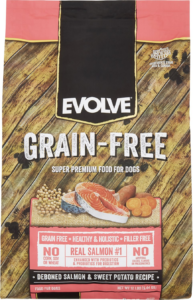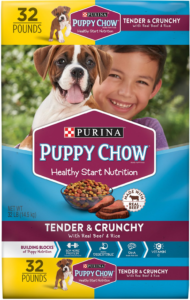If I were to ask you what dog food you buy, you’d probably say something like “Blue Buffalo Chicken” or “American Journey Salmon” without really knowing the exact name of the dog food off the top of your head. That may seem like a trivial thing to know, but the name of your dog food can be extremely telling as to the quality and honesty of what’s inside.
A pet food company can’t just go around naming their dog food whatever they want because there’s regulations in place for labeling pet food enforced by state governments and the FDA. The goal is to let consumers trust that what the manufacturer is advertising will be what you’re feeding your dog, but in practice many low quality foods (and even some good ones) can be very misleading while still adhering to the law.
Here’s an overview of the dog food naming regulations and some examples of dog foods that you may find misleading by their packaging.
“Dog Food”, “Recipe”, “With” and “Flavor”
There are 4 main rules for naming dog food if you want to include an ingredient name in the product name. You can think of these rules as “tiers” or levels of ingredient inclusion that must be met in order for a dog food to be labeled a certain way.
Dog Food named “Dog Food”
The highest level is the “dog food” level, such as “Chicken Dog Food” or “Beef Dog Food”. In these cases, the first ingredient in the name must make up 95% of the ingredients by weight in the dog food, or 70% of the ingredients when removing moisture content (meats contain a lot of moisture which make them heavy). It’s also possible to combine ingredients in the dog food name, as in “Chicken and Potatoes Dog Food” with the requirement that both ingredients combined must meet that 95%/70% threshold. The named ingredients must also be in the correct order where the first ingredient has more usage than the second.
In practice, these dog foods are extremely uncommon – I wasn’t able to find any examples with wide distribution in a kibble form though some fresh dog foods and homemade dog foods meet this standard. In a dry dog food it’s hard to pull off.
Dog Food named “Recipe/Formula/etc”
The next level of dog food is the “recipe” level. This level has lower requirements – the named ingredient(s) must only make up at least 25% of all ingredients’ weight (excluding moisture). When a dog food ingredient comprises at least 25% of the formula by weight, then it can be used in the dog food name with a qualifier such as “Recipe”, “Formula”, “Dinner”, etc. Here’s an example from Evolve of a dog food named “Deboned Salmon and Sweet Potato Recipe”.
There are many dog foods that follow this “recipe” naming convention. Now you know that when you see that kind of name, the dog food must have a good amount of the named ingredients inside!
Dog Foods that use “With”
The next step down is the “with” level. Here is where things get deceptive. A dog food can be named “with” any ingredient as long as it contains just 3% of that ingredient! This allows a manufacturer to highlight whatever ingredient they want, so long as there’s just a bit of it in the dog food.
For these dog foods you need to go to the ingredient list and see if the dog food is deceptive or not – it’s possible the ingredient they use in the name is the first ingredient listed and had just missed that 25% threshold. In the example below, this clearly isn’t the case!
This Puppy Chow says it’s “with Real Beef” on this label multiple times and even shows a picture of appetizing cooked steak, but when you look at the ingredient list you’ll find the first four ingredients are “Whole Grain Corn, Corn Gluten Meal, Poultry By-Product Meal, and Whole Grain Wheat”. Real beef doesn’t show up until the 9th ingredient on the list! This dog food actually has more poultry than beef, yet you would have no idea unless you went to the ingredient list yourself.
Dog Food “Flavor”
The last level of naming regulation is “flavor”. If you wanted to name a dog food “Salmon Flavor”, you don’t actually need to have any salmon in it whatsoever! It only has to taste like salmon to a dog. Anytime you see “flavor” in a dog food name you should always check the ingredient list because odds are it’s primarily corn and wheat with very little of the actual protein flavor mentioned. These are dog foods to avoid at all costs.
Always Check the Ingredients
The main takeaway here is that some dog food companies are misleading with how they name their dog foods while remaining within the laws and regulations. More important than memorizing any of these naming rules is the act of checking the ingredient list, which always lists primary ingredients first.
Some dog food companies simply don’t list a main ingredient in their food names such as Taste of the Wild which goes with more generic names that allude to ingredients like “Pacific Stream” or “High Prairie”. Other companies may use the phrase “With Chicken” even if chicken is a heavily used ingredient because they like the way it sounds or found consumers like the way it sounds. That’s why the best way to protect yourself is to go to the ingredient list and see for yourself what you’re feeding your dog.
by Kyle of Woof Whiskers



